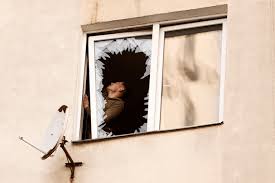
Ukraine Intensifies Strikes on Russian Airfields and Military Industry

 :
| Updated On: 13-Jun-2025 @ 12:26 pm
:
| Updated On: 13-Jun-2025 @ 12:26 pmSHARE
Over the past week, Ukraine has intensified its attacks on Russian airfields and defense infrastructure following its successful Operation Spiderweb, which destroyed several of Moscow’s strategic bombers on June 1. These targeted assaults have included strikes on fuel tanks at Engels airbase and fires at Dyagilevo airbase — both of which were earlier targeted in the same operation.
Ukraine’s counteroffensive also targeted Russia’s military-industrial complex, including the JSC Progress plant in Michurinsk and the Azot chemical plant in Novomoskovsk, both involved in producing critical war components like artillery stabilization systems and military-grade explosives. Ukrainian drones further disrupted operations at the Tambov Gunpowder Plant, a key supplier of gunpowder to the Russian army.
Geolocated footage confirmed multiple strikes. Ukraine also destroyed two fighter jets at Savasleyka airbase and caused fires at a plant in Cheboksary, which manufactures guidance systems and antennas for Shahed drones. These efforts aim to halt Russia’s production of glide bombs, which are being used heavily against Ukrainian front lines — with Russia reportedly deploying over 3,000 per month.
Despite Ukraine's targeted interdictions, Russia has responded with overwhelming aerial attacks, deploying more than 1,400 Shahed drones and at least 59 cruise missiles in a week. Major cities including Kyiv, Kharkiv, and Dubno came under attack, resulting in dozens of casualties. Kyiv alone faced a devastating wave of 407 drones and 45 missiles on Friday. The Ukrainian Air Force intercepted hundreds of these, including 479 out of 499 Russian air targets on Sunday night.
Ukraine’s defenses have managed to shoot down most incoming threats, but the intensity of Russian assaults remains high. A new jet-propelled version of the Shahed drone capable of speeds up to 600 km/h has also been used for the first time, signaling a technological upgrade in Russia’s drone fleet. Russia can now reportedly manufacture 2,700 Shahed drones and 2,500 decoys per month, up from 500 annually last year. Moreover, it has reportedly partnered with North Korea to co-produce drones.
Ukrainian President Volodymyr Zelenskyy warned this development poses a grave threat not just to Europe but also to East and Southeast Asia, urging global powers to act before upgraded drones begin threatening cities like Seoul and Tokyo.
Meanwhile, in a significant development on the ground, Russian forces reached the border of Ukraine’s Dnipropetrovsk region for the first time in over three years of war. While fighting continues in Donetsk, footage confirmed the Russian presence in Dnipropetrovsk. Russia’s Defense Ministry stated their aim is to create a buffer zone in the region, similar to their previous arguments in Kharkiv and Sumy.
On the diplomatic front, the EU and US are increasingly diverging. While European nations are ramping up aid — the UK announced $476 million for 100,000 drones, and Germany is funding long-range weaponry — the US has frozen support under President Donald Trump. Secretary of Defense Pete Hegseth skipped the Ukraine Contact Group meeting, and 20,000 anti-drone rockets meant for Ukraine were redirected to US forces in the Middle East.
The European Commission proposed its 18th package of sanctions against Russia, targeting banks, energy revenues, and military links, while tightening price caps on Russian oil and banning transactions related to the Nord Stream pipeline.
Contact Us
House. No. : 163, Second Floor Haridev Rd, near Puberun Path, Hatigaon,Guwahati, Assam 781038.
E-mail : assaminkcontact@gmail.com
Contact : +91 8811887662
Enquiry
×
Reporter Login
×